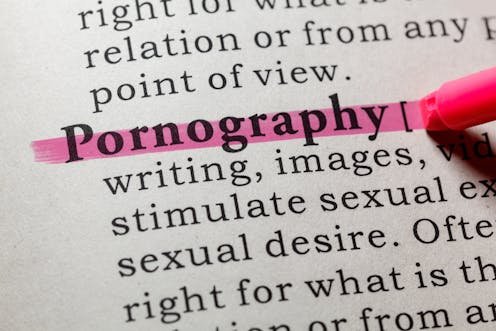We need a new definition of pornography
- Written by Sarah Ashton, PhD Candidate, Monash University

We all think we know what pornography is, whether we oppose it, use it, or tolerate it. But are we all conjuring up the same images?
The term has been used to describe, for example: a music video clip of a naked Miley Cyrus straddling a wrecking ball; Bill Henson’s photographs of naked children, hung in art galleries; and forceful sex scenes in Game of Thrones.
Our Google search using the term “porn” yielded 3 billion results with every sexual act imaginable (and plenty we could never imagine).
Before we began our research on the meaning of pornography in young women’s lives, we wanted to define it. Our review of the literature found no consistently used definition.
Many social science researchers did not define pornography. From those who did, we drew out several key components: the content and its delivery (for example, whether it was “sexual in nature”), the intention of the producer (whether it was “intended to arouse the viewer”), and the perception of the consumer (whether it was “deemed sexual”).
Sometimes researchers referred to what the general public might think (most people would think it is pornography, “given the context”).
It was notable that there was no mention of consent in any of the definitions we reviewed. Where do we place sexual material that is produced and distributed without consent from the people involved?
We are convinced that we cannot understand pornography without considering consent, and that pornography must be differentiated from sexual abuse. We therefore propose a new definition of pornography:
Material deemed sexual, given the context, that has the primary intention of sexually arousing the consumer and is produced and distributed with the consent of all persons involved.
In 2019, the question “What is pornography?” doesn’t have an easy answer. The advent of smart phones has revolutionised the production and distribution of sexualised videos and images.
When someone uses their phone to send another person an image of their own naked body or body part, this consensual sharing of sexual images is called “sexting”. Smartphone users can also choose to film sexual activities and share the images on websites for others to view.
Virtual reality technology, high-speed video chat streaming, and online gaming are also used to distribute sexual content. If the people involved have the capacity to freely consent (there are many factors that contribute to this, including being over 18) to the production and distribution of images, films, or digital content, and they want this content to be consumed for sexual arousal – we would refer to this as pornography.
Read more: Virtual child pornography could both help and hinder law enforcement
Unlike sexting, “revenge porn” is the distribution or publication on a website of sexual material without the consent of the person depicted. This usually follows the ending of an intimate relationship. The vengeful person publicises the images that were assumed by the subject or sender to be confidential.
Revenge porn websites encourage users to submit nude and sexual photographs of their ex-partners explicitly for revenge and to include the victim’s contact details and links to their social media accounts.
When an adult produces or distributes a sexual image of a child, it’s usually called “child porn” and is a criminal offence because (among other reasons) children cannot legally give consent. Once images have been shared, they have a perpetual life on the net, maintaining the victim’s experience of abuse. As with revenge porn, there is potential for endless damage to the victim.
It is perplexing, therefore, that the terms “revenge porn” and “child porn” tend to be used without differentiating these inherently violent acts from consensual pornography. To describe them this way normalises sexual violence occurring in the digital realm.
Words matter. Disregarding consent by describing acts of non-consensual violence as “pornography” has the effect of minimising the significance of consent.
Read more: AI can now create fake porn, making revenge porn even more complicated
There is, of course, violent sexual material that is produced and distributed with consent from those involved. The violent acts seen in what is known as Bondage, Domination, Sadism, and Masochism (BDSM) material are preceded by the actor’s recorded consent.
One can also find online, however, a plethora of violent sexual material with no evidence of consent. It is theoretically possible to discover whether consent was obtained for production and distribution. But we can claim with confidence that so-called “revenge porn” and “child porn” are incidents of non-consensual sexual abuse.
Content that is produced and distributed without consent should be referred to as sexual abuse material, not as pornography. Our opinion is consistent with that of the Australian Government’s Children’s eSafety Commissioner, who has recommended that non-consensual material be referred to using terms such as “online sexual abuse”.
A definition can be a powerful instigator of social change. Considering consent and taking account of this definition amounts to a personal contribution to the prevention of sexual violence. We can do it today.
Authors: Sarah Ashton, PhD Candidate, Monash University
Read more http://theconversation.com/we-need-a-new-definition-of-pornography-with-consent-at-the-centre-111994



